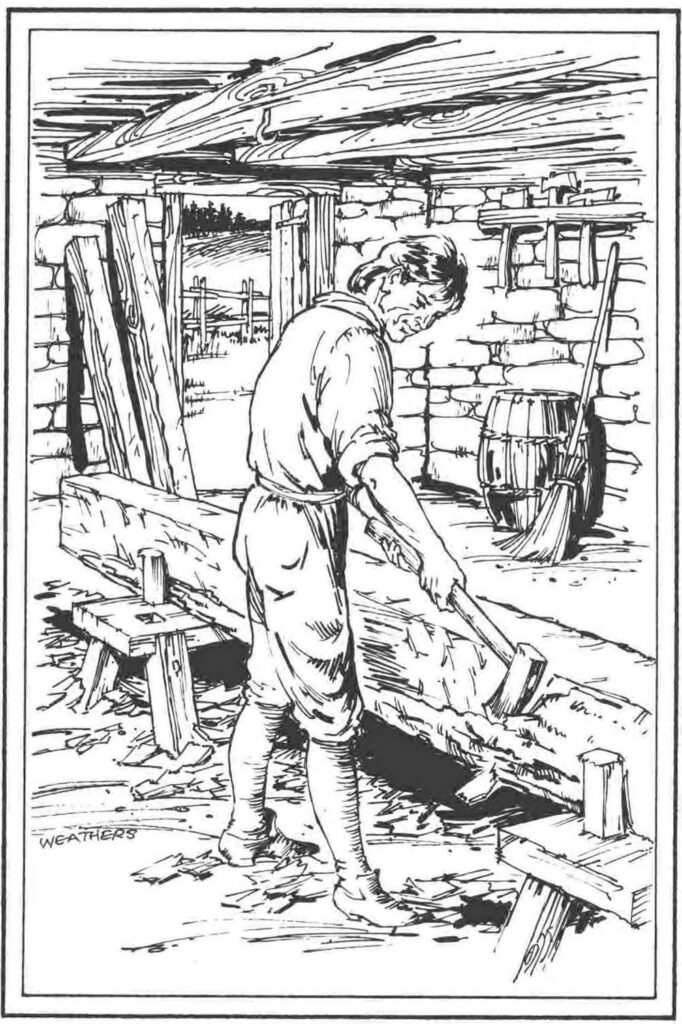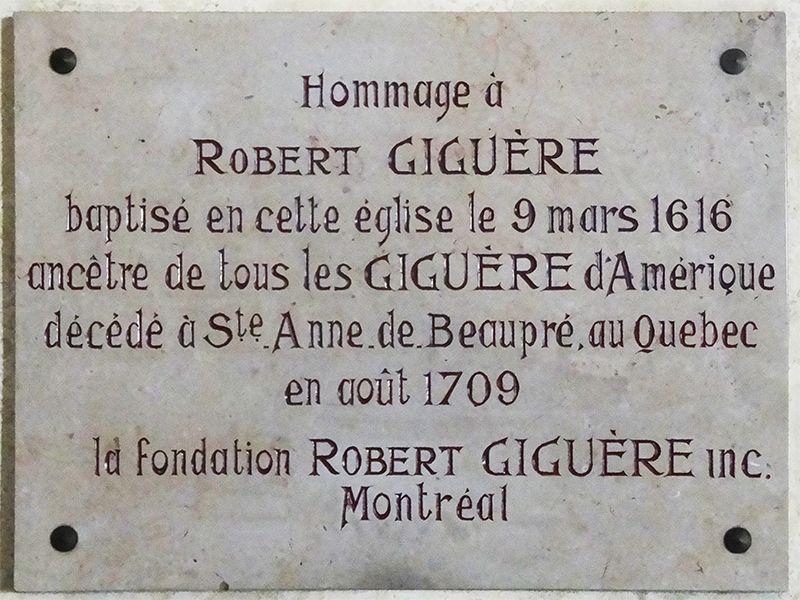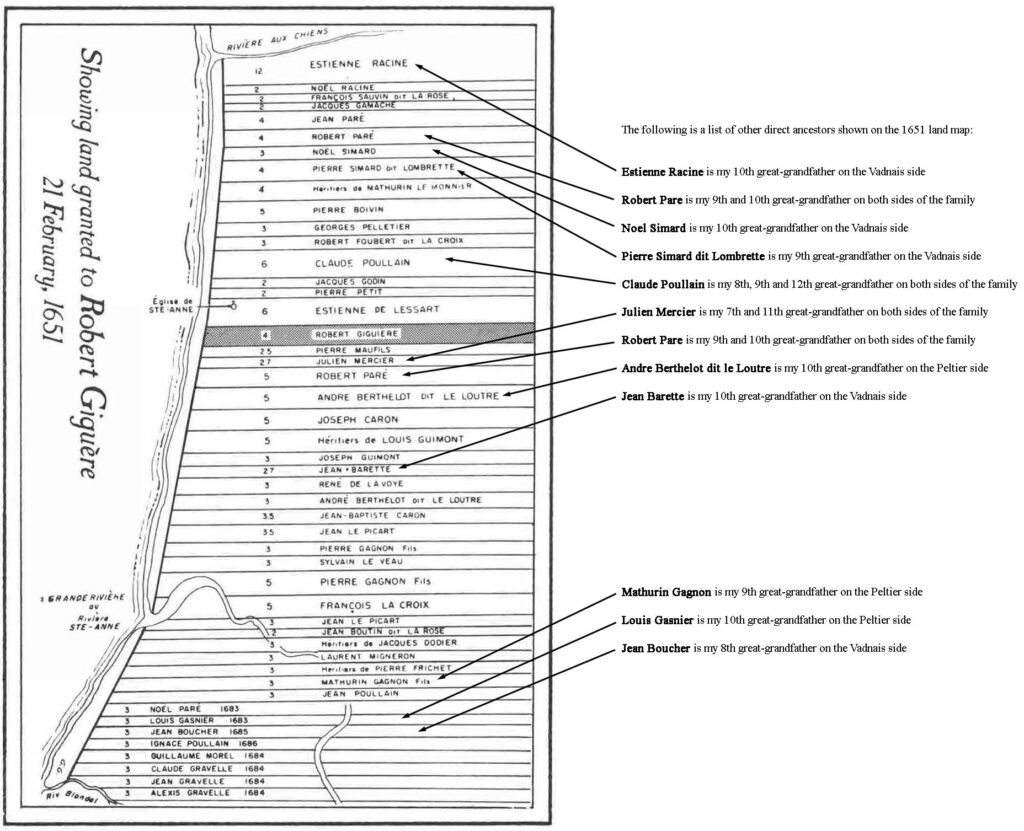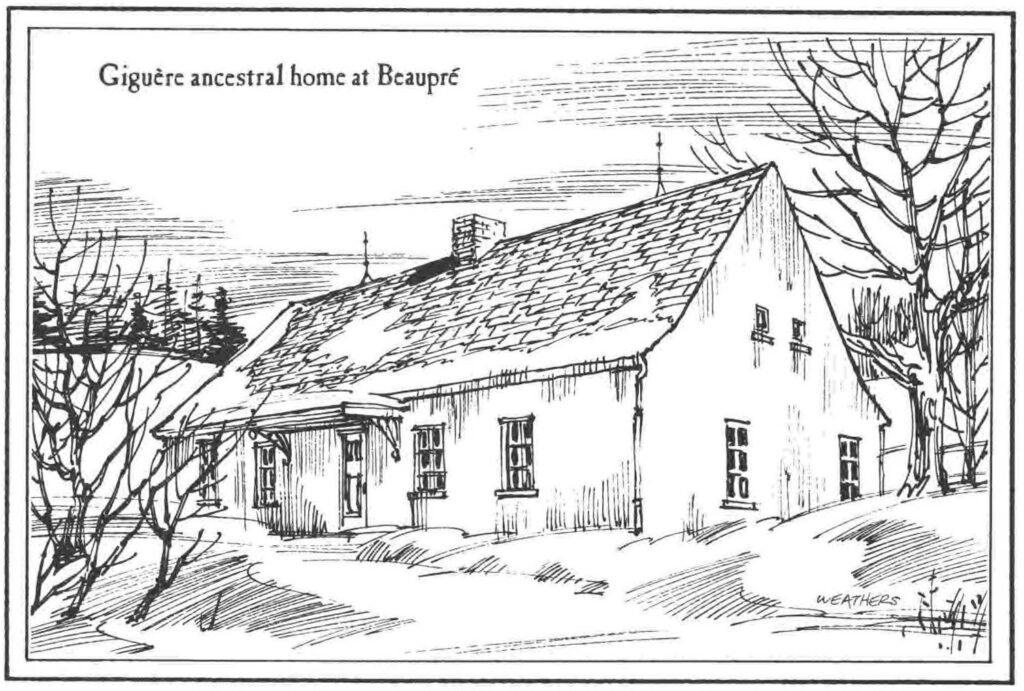Many of our ancestors have been documented in a 30-volume series of books titled “Our French-Canadian Ancestors.” The stories first appeared in French in the Sainte-Anne Revue and were later revised and translated into English by Thomas J. Laforest. The following story1 from volume II is about Robert Giguere, my 7th, 9th and 10th great-grandfather on both the Vadnais and Peltier sides of the family. I’ve included some additional images of documents.

“On 9 March 1616, in the parish of Saint Aubin of Tourouvre [France], Michelle Jornal [my 8th, 10th and 11th great-grandmother on both sides of the family] gave birth to Robert Giguere, her 16th child. The son of Jehan Giguére [my 8th, 10th and 11th great-grandfather on both sides of the family], Robert would come to be responsible for the spread of this surname throughout New France and, subsequently, North America. Little is known about his infancy, his adolescence and even his adult life, which we can suppose to be occupied with clearing and farming the land. Today, not far from the place of his birth, there is a spot called La Giguerie, in other times known as la Giguerrerie. Nothing else remains of the orthography of the name in this corner of France.


It reads: Tribute to Robert Giguere baptized in this church on March 9, 1616 ancestor of all the GIGUEREs of America died in Ste Anne de Beaupre Quebec in 1709
In 1644, Robert Giguere is reported to be absent from the country. Where might he be? Perhaps already busy exploring the Quebec region? There is no reason to believe that he did not come to Canada about 1645 and then do his service of indenture for at least three years, or maybe even five or six.
On 21 February 1651, Robert Giguere received a grant of land from Sieur Olivier le Tardif. It was in Beaupre, had five arpents fronting on the Saint-Lawrence River to a depth of a league and a half [about 4.5 miles deep by 960 feet along the river] and, in addition to the annual rent of 20 sols and 12 deniers per arpent of frontage, it required Robert to establish a residence thereon within the year. If Giguere was in a position to accept such conditions, it may be assumed that he had been already in the country for some years and was familiar with the land, the climate, and was ready to settle down. His neighbors were Julien Mercier [my 7th and 11th great-grandfather on both sides of the family] and Etienne de Lessart.
On 2 July 1652, Robert Giguere married Aymee [Aimee] Miville [my 9th, 11th and 12th great-grandmother on both sides of the family]. She was born at Bourage in France, from the marriage of Pierre Miville dit le Suisse and of Charlotte Maugis [my 8th, 10th and 11th great-grandparents on both sides of the family]. After publication of the banns of marriage on the 23rd, 24th and 30th of June, from the pulpit of the church of Notre-Dame de Quebec, and not having found any legitimate objection thereto, Father Joseph Poncet married them in the presence of several witnesses, among whom was Jean de Lauzon, Governor of New France and Lieutenant-General Nicolas de Hauteville, Provost of Québec.
In 1658, the parish of Sainte-Anne-de-Beaupre’ was established on the riverfront between the Riviére-aux-Chiens and the Riviére Sainte-Anne. Originally it was called Sainte-Anne-du-Petite-Cap and counted about 20 families. We can see the grant [below] of Robert Giguere sandwiched in between that of Julien Mercier and Etienne de Lessard, very convenient to the church, first erected in 1658. According to the Royal Notary Guillaume Audouart, in a document recorded on 5 March 1658, de Lessard gave two arpents to the church to have a chapel erected for the newly created parish. Being located so near to this activity, our ancestor must have been involved with the construction of the edifice and its subsequent relocation to higher ground.

Sainte-Anne is just above Quebec City along the Saint-Lawrence River. Notice that each band of land is attached to the Saint-Lawrence River (on the left); it was the prime mode of transportation, so everyone would have had access. Even now when you fly over Quebec the ribbons of land are quite noticeable.
During the next 25 years, the Giguere couple had 13 children, evenly spaced at two-year intervals. The first was Charlotte, born 23 October 1653 and baptized at Notre-Dame de Quebec on 5 April 1654. The second was Martin, born 2 January 1655, also baptized at Notre-Dame. [Martin is my 8th and 9th great-grandfather on the Peltier side of the family]. The third was Jeanne, born 22 July 1657, and baptized at Notre-Dame. Marie, the fourth, first saw the light of day on 12 April 1659, a short time before the arrival of Msgr [Monsignor] Francois de Laval, the first Bishop of Quebec. She, too, was christened in the Québec mother church. The fifth child, Jean-Baptiste, arrived in 1660, the same year that his mother and father were confirmed at Chateau-Richer by Msgr [Monsignor] de Laval, along with 170 other adults. The baptisms of the next three children were all recorded at Chateau-Richer: Robert Junior, born 28 January 1663; Pierre, born 10 August 1665 and Anne, born 18 September 1668. The registers of Sainte-Anne, begun only in 1669, contain the baptismal records of the last five Giguere children: Etienne, born 25 May 1670; Angelique, born 3 January 1672; Joseph, born 20 August 1673 [my 6th great-grandfather on the Vadnais side of the family]; Agnes, born 19 March 1675 and Marguerite, born 5 June 1678. All of the children were born at home in the house which was enlarged along with the family. All were either baptized at home or in the little church of Sainte-Anne. In those days, the priest walked his parish, visiting each family in turn. Then, on his return to the parish church, he would record the vital statistics. Thus we may see that even though the baptismal record was kept at a church, it was not necessary that the child be taken there for the event.

The family spread out as it grew. Martin, by his marriage to Marie-Francoise Pinard on 7 May 1682, took the Giguére patronym to Sorel and Trois-Rivieres [my 8th and 9th great-grandparents on the Peltier side of the family]. By his marriage to Louise Magnan, Jean-Baptiste settled at Montreal, where his children perpetuated his name. The continued presence of the Giguéres at Sainte-Anne was assured by the marriage of Joseph to neighbor Marie Angelique Mercier, daughter of Julien, on 11 November 1698 [my 6th great-grandparents on the Vadnais side of the family].

It is quite possible that the Giguere family did not live in the house so near the church at Sainte-Anne continuously. During the period from 1656 to 1660, the Iroquois were marauding up and down the Beaupre’ coast. Many families were forced to evacuate to Chateau-Richer, among whom were the Robert Carons, the Jean Picards and the Claude Bouchards [my 9th great-grandfather on the Vadnais side of the family]. Might not the Robert Giguéres have followed the movement, which the historian Yvanhoe Caron spoke of in these terms: “The Iroquois incursions became more and more menacing; a declaration of the Seigneurs Olivier Ie Tardif and Julien Fortin, tell us that many families, acting on the advice of Governor Pierre Voyer d ‘Argenson, had abandoned Beaupre’ in order to retreat to Chateau-Richer…”
During the period from 1658 to 1698, the Sainte-Anne parish “Register of Receipts and Disbursements” is replete with entries about the Giguéres. His tithing, the payment for pew rental, the price of labor and material expended in construction of the new church, his donations, even the cost of subsistence of a carpenter in his house who was employed by the church, was recorded in the register. Incidentally, it was this carpenter in residence, one Jean-Baptiste Bau, who courted and won the hand in marriage of the last Giguere daughter, Marguerite. They were married on the first of April, 1704.
Robert Giguere was also a public-spirited man. He held the post of head-vestryman at Sainte-Anne, succeeding Jean Picard, who was the first. Two sons followed their father’s example: Joseph in 1708 and Etienne in 1711; both became head-vestrymen.
After a period of silence in the affairs of Robert and Aymée, during which, no doubt, they were preoccupied with their children’s marriages and relocations, we come to the watershed year of 1704. Only son Joseph, among all the boys, remained in the area with his wife, Marie Angélique Mercier. It was to them that the parents turned to be assured of some security in their old age. In August of 1704, the father and mother made a donation of their assets in favor of son Joseph, in return for the assurance that their simple needs would be met.
Joseph may have been a good and faithful son to his parents, but the parish records of ’’Receipts and Disbursements” tell a story of a Joseph who was tardy and reluctant in the payment of his dues to the church. Even though it was Joseph and no longer Robert who was responsible for the payment of pew rent, he did so only every two years: Even when he was head-vestryman he was slow to pay. When his father died, it took Joseph fourteen months to pay ”bit by bit” for the service and burial.
There is no death certificate recorded for Robert Giguére, an oversight no doubt, or perhaps it has been lost. However the date of his demise has been established as August of 1709. He was 93 years and 5 months old. Aymee Miville, wife and mother, followed on 10 December 1712.
FAMILY NAME VARIATIONS
The family descendants, following the custom of those times, adopted many other surnames. We know of the following: Bellerose, Delfrene, Despins, Dolsesses, Douville, Geiére, Gehiére, Giére, Gigaire, Gigere, Gigger, Giguier, Giguierd, Giguérre, Giguieres, Gigur, Giliére, Gilliére, Guhiére, Guihiére, Higgins, Jierre, Jigger, Jihiére, Juhiere, Lavallee, Saint-Castin and Saint-Quentin.”
Thanks for visiting, come back soon,
Cindy
© 2023 Copyright by Cynthia Vadnais, All Rights Reserved

Robert Giguere is my 9th great-grandfather also.
Thanks Cindy, I love reading about our ancestors.
Do you have a picture of Souphronie Giguere, married to Théophile Gravel on 8/4/1866?
No I don’t, I doubt that any picture exists of her. 1866 is in the infancy of photography.
My ancestors on my mother’s side had a count named Robert Giguere and he had a castle in Perche , France that still stands today. My grand mother was so proud of her blue blood and so was my uncle Paul, he bragged about his blue blood.. He went to the chateau in France and he loved the place, I never had the pleasure of seeing France but believe me I get money I will, and I will walk in the chateau in honor of my mother’s family and my ancestors. I am proud to have blue blood also and I always were. My uncle Paul was stationed in France in the second war that’s how he got to go and see France and look up ancestry.